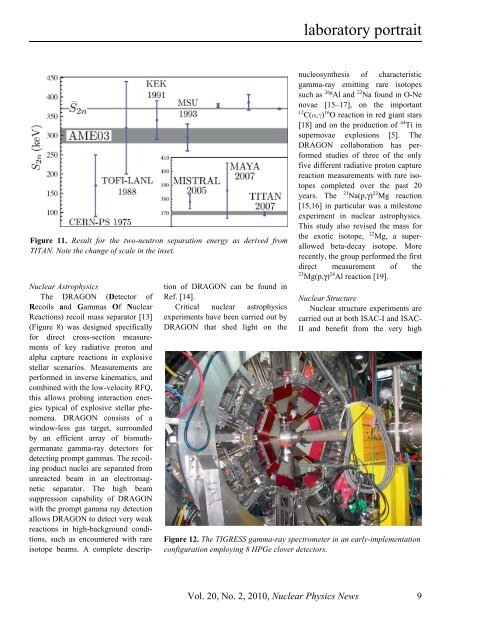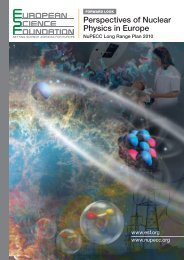Create successful ePaper yourself
Turn your PDF publications into a flip-book with our unique Google optimized e-Paper software.
laboratory portraitFigure 11. Result for the two-neutron separation energy as derived fromTITAN. <strong>No</strong>te the change of scale in the inset.Nuclear AstrophysicsThe DRAGON (Detector ofRecoils and Gammas Of NuclearReactions) recoil mass separator [13](Figure 8) was designed specificallyfor direct cross-section measurementsof key radiative proton andalpha capture reactions in explosivestellar scenarios. Measurements areperformed in inverse kinematics, andcombined with the low-velocity RFQ,this allows probing interaction energiestypical of explosive stellar phenomena.DRAGON consists of awindow-less gas target, surroundedby an efficient array of bismuthgermanategamma-ray detectors fordetecting prompt gammas. The recoilingproduct nuclei are separated fromunreacted beam in an electromagneticseparator. The high beamsuppression capability of DRAGONwith the prompt gamma ray detectionallows DRAGON to detect very weakreactions in high-background conditions,such as encountered with rareisotope beams. A complete descriptionof DRAGON can be found inRef. [14].Critical nuclear astrophysicsexperiments have been carried out byDRAGON that shed light on thenucleosynthesis of characteristicgamma-ray emitting rare isotopessuch as 26g Al and 22 Na found in O-Nenovae [15–17], on the important12 C(a,g) 16 O reaction in red giant stars[18] and on the production of 44 Ti insupernovae explosions [5]. TheDRAGON collaboration has performedstudies of three of the onlyfive different radiative proton capturereaction measurements with rare isotopescompleted over the past <strong>20</strong>years. The21 Na(p,γ) 22 Mg reaction[15,16] in particular was a milestoneexperiment in nuclear astrophysics.This study also revised the mass forthe exotic isotope, 22 Mg, a superallowedbeta-decay isotope. Morerecently, the group performed the firstdirect measurement of the23 Mg(p,γ) 24 Al reaction [19].Nuclear StructureNuclear structure experiments arecarried out at both ISAC-I and ISAC-II and benefit from the very highFigure 12. The TIGRESS gamma-ray spectrometer in an early-implementationconfiguration employing 8 HPGe clover detectors.<strong>Vol</strong>. <strong>20</strong>, <strong>No</strong>. 2, <strong>20</strong>10, Nuclear Physics News 9
















